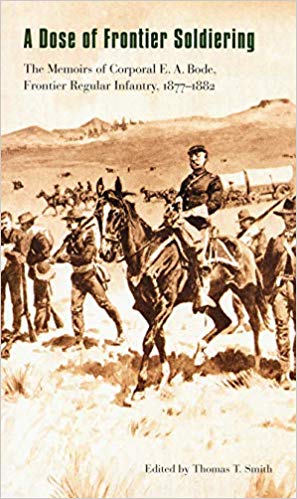On a cold day in February 1877, an emigrant named Emil A. Bode volunteered for the infantry. Bode listed his civilian job as laborer, but was unemployed, most likely as a result of the Panic of 1876 when Wall Street losses tanked the economy. Unemployment is still a primary motivation for joining the military.
Bode (pronounced Bodie) passed the entrance physical and in March 1877, he enrolled in Company D, 16th Infantry Division. After two months in the army, Bode’s first payday arrived. A long row of conmen, professional gamblers and prostitutes were waiting to relieve the soldiers of their pay and most of the men were broke by sunset. Bode noted that this pattern repeated every payday.
In June 1877, the 16th Infantry boarded a train in New Orleans headed for St. Louis. From there the train took them west across Missouri, then southwest into Kansas on the way to Indian Territory. They disembarked at Caddo, Indian Territory (now Oklahoma), and marched the last 165 miles west to Fort Sill. For the next three years, Company D was based at Ft. Sill.
Frontier duty for infantrymen involved boredom and hard work. They dug ditches, planted vegetable gardens, repaired telegraph lines and stood guard over the haystacks that would feed their livestock through the winter. The first time Bode was posted on nighttime guard duty he fell asleep at his post. When he awoke, he found a pack of wolves closing in on him. He threw clods of dirt at the wolves until they decided to leave.
As the wolves loped away, Bode heard the clink of an officer’s sword. Every night the officer of the day walked round the guard posts to check that no one had fallen asleep. As the officer rounded the haystack, Bode brought his gun to “charge bayonets” and called “Who comes there”? The officer froze until he was told to “advance and be recognized”. Enlisted men live for such small victories against officers.
Bode spent about half his time on detached service. Most of the detached service involved repairing the telegraph lines that connected the frontier forts. They also chopped down trees to stockpile firewood for the winter. Bode enjoyed detached service because he always had time to go exploring and hunting.
Most of the soldiers were hunters. It allowed them to supplement their army rations with fresh meat. Raccoon, wild turkey, mountain lion, and antelope were plentiful and were a welcome break from beef and hardtack.
When wild game was scarce, the soldiers acquired a hog or beef cow owned by a local farmer. If caught, the company had to reimburse the farmer for the loss. One farmer claimed such an exorbitant fee for his dead hog, that the soldiers were outraged by his greed. After that, the soldiers made a point of snatching one of his hogs every time they passed near his farm.
In 1880, Bode’s company was transferred to New Mexico Territory to take part in the Victorio campaign. Victorio was a Mimbres Apache who fled the reservation and began raiding in Arizona and New Mexico territories and Old Mexico. Bode’s company guarded stage stations and ranches but never saw any combat during the campaign. Victorio was eventually killed by a Mexican army unit.
The 16th Infantry moved to Ft. Gibson, Kansas only to receive new orders transferring them to Ft. Davis, Texas. In February 1881, Bode’s five year hitch was up. To entice him to re-up, he was promoted to sergeant. But Bode decided he’d had enough of low pay, slow promotions and lousy working conditions. Many soldiers in today’s volunteer Army make the same choice, creating a constant brain-drain of experienced personnel.
Despite never being in combat, Bode lived through many dangerous adventures which he chronicled in a journal. His journal is reproduced with explanatory notes in A Dose of Frontier Soldiering, E.A. Bode (Edited by Thomas T. Smith, 1994.)
Want to receive this blog straight to your inbox? Sign up for my mailing list.
You can also follow me at HerSavvy.com. My column appears the 3rd Tuesday of each month.




